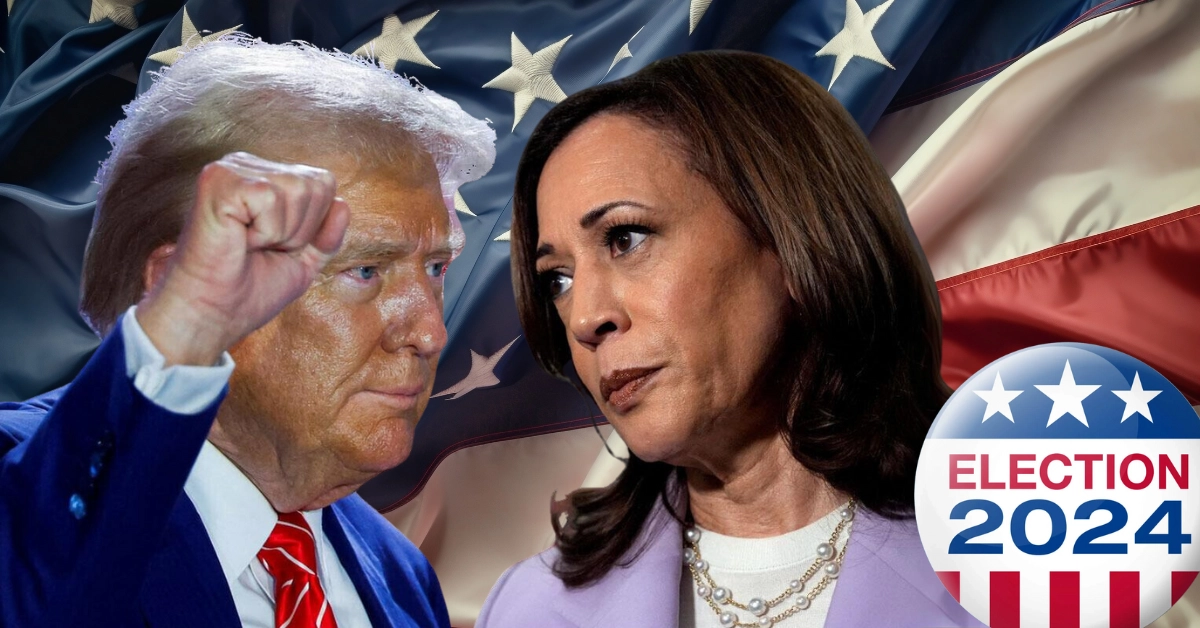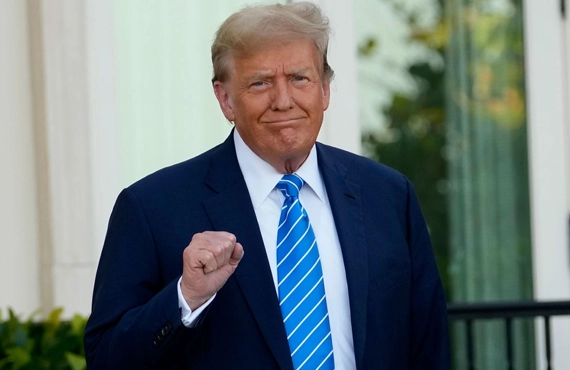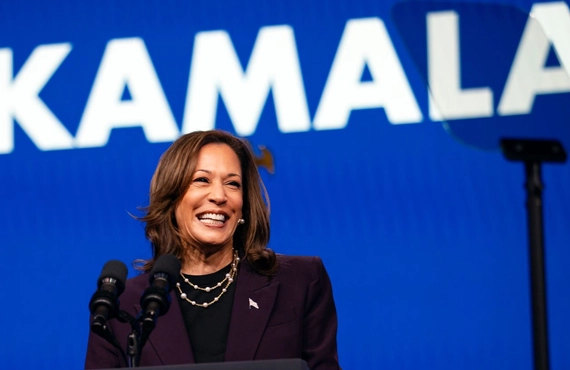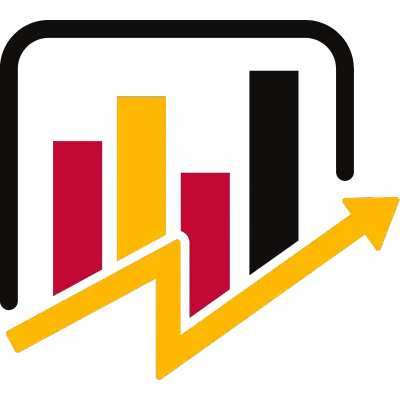2024 US Presidential Election Predictions: Polls, Odds and the Path to Victory

Welp, the 2024 Presidential Election is less than a month away, and it’s probably the most consequential race of our lifetime for democracy. But depending on who you ask, the reasons why will differ wildly. Liberals will say it’s because one candidate is a threat to our democratic “experiment” that’s been ongoing since 1789. Republicans will say that the other candidate is a “commie,” which means they think they are a threat to democracy.
And the polls are showing the race is pretty tight and “within the margin of error.” So obviously, everyone is hyper-focused on every poll that comes out—especially those who are betting on the outcome of the election for money.
Whether you are exhausted from the political circus or have a dog in the fight, there are three things everyone is obsessed with in this election: the polls, the betting odds, and the different ways the candidates can secure a win. The polls do give us a good idea of where voters’ heads are at; betting odds bring out the gamblers and the number crunchers and the road to victory? Well, that’s where it gets even more cuticle-tearing—both candidates on the ticket are tiptoeing through a battleground of swing states and razor-thin margins.
For all of you political junkies, the ones observing like you’d watch a train wreck, or those of you who have actual money riding on the outcome, we are going to unpack it all!
Current Polling Data and Trends
As we barrel toward Election Day 2024, the polling landscape is a mixed bag of nail-biting suspense, shifting numbers, and a lot of what-ifs. The Presidential race, featuring Vice President Kamala Harris and former President Donald Trump, is tighter than a drum. With each new poll release, we see fluctuations that hint at the larger picture while leaving room for uncertainty. Given the unpredictable nature of modern elections, it’s no wonder that poll watchers are glued to their screens.
Now, it’s important to remember that polls only show a moment in time—they tell us what a subset of the population is thinking right now, but they can’t and don’t account for last-minute shifts, actual election day turnout, or any October surprises. That said, we can glean some obvious trends and insights from the currently available data that is out there.
Overview of Key Polls
Right now, most of the major polls paint a picture of a closely contested race. According to recent polling averages from RealClearPolitics, the national race between Harris and Trump is effectively within the margin of error, which means neither side can claim a comfortable lead. Depending on the day or the poll, you’ll see Trump edging ahead slightly in key battleground states, while Harris holds a slim advantage nationally and in traditional Democratic strongholds.
For instance, recent polls from The Hill and Decision Desk HQ show Harris is leading by small margins in Michigan and Arizona, both of which are critical swing states. But on the other side of the political spectrum, Trump is making inroads in Florida and Ohio, states that he won in 2020 and is relying on once again. In Pennsylvania, which is one of the most important states in the entire election, Trump and Harris are neck-and-neck, with some polls showing Trump ahead by a single point while others show a slight Harris lead.
The trends we’ve seen over the past few months also reflect the ebb and flow of public opinion as the candidates battle it out. Earlier in the year, Harris had a more comfortable lead, but Trump has gained ground in recent months, particularly as the economy continues to weigh heavily on voters’ minds. Inflation, job security, and rising costs are all pressing issues that have shifted support, especially in suburban and rural areas. Meanwhile, Harris has maintained her edge among younger voters, urban dwellers, and people of color.
Key Demographics to Watch
If you’ve followed any presidential election in the past two decades, you know just how important demographics are in shaping the outcomes, and this election is no outlier. Polling data reveals some clear demographic patterns that will play an outsized role in deciding who wins in November.
Younger voters, particularly those under 30, are overwhelmingly leaning toward Harris. This group has consistently favored progressive policies, and they are more likely to be concerned about issues like climate change, healthcare access, and social justice. However, while they lean Democratic, turnout among younger voters has historically been lower, so Harris will need to focus heavily on mobilizing this group to ensure they actually show up at the polls.

In contrast, older voters, especially those over 65, continue to favor Trump. This group is more likely to prioritize issues like national security, immigration, and maintaining traditional values, areas where Trump’s messaging has resonated strongly.
Another demographic worth watching is suburban women, who swung hard toward Biden in 2020 after years of being a reliably Republican group. Polls indicate that suburban women are split this time around, making them a true wildcard in key states like Pennsylvania and Georgia. Harris will need to convince this group that she can handle economic concerns, while Trump will likely focus on crime, education, and family values to win them back.
When it comes to race, Harris has a strong base of support among African American and Latino voters, although Trump has made inroads with Latino voters in some regions, particularly in Florida and Texas. The Latino vote, in particular, is not a monolith, and how Harris and Trump appeal to different segments of this demographic—whether Cuban-Americans in Miami or Mexican-Americans in Arizona—will be critical.
Swing States
In every presidential election, swing states become the battlegrounds that decide the outcome, and 2024 is no different. Florida, Pennsylvania, Arizona, Wisconsin, Michigan, and Nevada are among this cycle’s most hotly contested states. While national polling can give us a broad overview, it’s the state-level polling that truly matters, as the U.S. electoral system is determined by the Electoral College, not the popular vote.
- In Florida, Trump has been consistently polling ahead of Harris, with some surveys showing him leading by five or six points. This state has been trending Republican over the past few elections, and it’s a critical part of Trump’s pathway to victory. Harris, on the other hand, is pinning her hopes on states like Arizona and Nevada, where recent polls show her with a narrow edge.
- Pennsylvania, a perennial swing state, remains one of the most important in the race. It’s a state that Trump narrowly won in 2016 but lost in 2020. The polls here have been volatile, with both candidates trading slim leads, making it clear that Pennsylvania will likely go down to the wire.
- In the Midwest, states like Wisconsin and Michigan are also pivotal. Polling shows these states to be true toss-ups, with both candidates running neck-and-neck. The outcomes in these states will depend heavily on voter turnout, particularly in the cities versus rural areas, where there are stark differences in political preferences.
Polling Accuracy
Polling accuracy has been a hot topic in recent years, especially after the 2016 and 2020 elections, where polls either underestimated or overestimated support for certain candidates. Many pollsters have since adjusted their methodologies to account for things like “shy” voters or hard-to-reach demographics, but there’s always a margin for error.
Polls are only as good as the data they’re based on, and there are many factors that can throw off predictions. For one, voter turnout is notoriously difficult to predict, and pollsters often struggle with how to weigh certain groups.
For example, younger voters tend to support Democrats, but if they don’t turn out in large numbers, the polls may overestimate Democratic support. Similarly, the rural vote has been tough to capture accurately in recent cycles, leading to some surprises in favor of Republicans.
Then, there’s the issue of last-minute developments—whether it’s a news event or a viral social media moment—that can sway undecided voters just before Election Day. In 2020, the polls ended up being more accurate than in 2016, but there were still significant misses in key states like Florida and Ohio.
So, while the polls give us a useful glimpse into the race, it’s essential to remember that nothing is set in stone.
Betting Odds: What the Market Is Predicting
As we approach the final stretch of the 2024 U.S. Presidential election, betting markets have become an increasingly popular way for people to follow the race. The odds aren’t just a fun addition—they usually show a real-time pulse on the voter sentiment that is shaped by polls, campaign developments, and major news events. The stakes are higher than ever, and for those looking to place bets, now is the time to watch the odds like a hawk.
Overview of Election Betting Markets
Election betting markets function pretty similarly to sports betting–you place a bet on the outcome—whether it’s on a candidate winning the presidency, taking the popular vote, or even winning individual swing states. Odds are updated constantly, reflecting how money flows into the market and how bettors feel about each candidate’s chances.
Many bettors are drawn to political markets because they provide an alternative view to traditional polling. While polls offer a snapshot of public opinion, betting odds reflect where people are willing to put their money. Historically, betting markets have sometimes been more accurate in predicting election outcomes than polls.
In 2016, for example, while most polls heavily favored Hillary Clinton, betting odds were more tempered, reflecting the possibility of a Trump victory.
Of course, betting markets aren’t flawless. Media narratives, sudden events, or even viral tweets can and do influence them. But they provide a dynamic view of how the public perceives the election at any given moment and can be a really useful tool for gauging momentum shifts in the race.
Current Odds for Leading Candidates
As of mid-October, Donald Trump leads the betting markets, with odds generally ranging between -138 and -150, giving him an implied probability of around 58-60% to win the election. Kamala Harris, who entered the race following President Biden’s decision not to run for a second term, trails at odds of +105 to +110, meaning her implied chances hover around 47-48%.
Interestingly, these odds have fluctuated throughout the year. Earlier in 2024, Harris was seen as the favorite when Biden stepped down, and the Democrats quickly consolidated around her campaign. But as economic concerns and public sentiment shifted, Trump regained his edge, especially as he locked down key endorsements and focused his messaging on the economy and national security.
Breakdown of Odds from Major Betting Platforms
Here’s a quick look at the latest odds from major betting apps as of mid-October:
| Site | Trump | Harris |
|---|---|---|
| -138 | +110 |
| -115 | +105 |
| -138 | +110 |
The odds can change quickly, especially as campaign events or national news shifts public perception.
Comparison to Previous Elections
The 2024 betting markets bear some resemblance to previous cycles. In 2016, Trump was consistently the underdog, with odds as high as +375 in the weeks leading up to Election Day. Polls showed Clinton ahead, but the betting markets were less certain, hinting at a possible upset. And we all know how that played out—Trump defied the odds and polls alike to win the presidency.
In 2020, betting odds swung back and forth between Trump and Biden, particularly during the debates and in the wake of the COVID-19 pandemic. By Election Day, Biden had become the clear betting favorite, with odds around -175, which accurately predicted his victory.
For 2024, Trump’s odds are notably stronger than in his previous campaigns, suggesting that many bettors see him as the candidate with more momentum heading into the final weeks. However, Harris remains competitive, and her odds could shift depending on how the remaining weeks of the campaign unfold.
Factors Affecting the Odds
A variety of factors are at play in the 2024 election that influence betting odds and some of them are more unpredictable than others:
- Economic Conditions: The state of the economy, particularly inflation and unemployment, has a massive impact on how voters perceive the incumbent party. Trump’s messaging around economic issues has resonated with a large segment of the electorate, which has helped his odds rise in recent months.
- Legal Issues and Scandals: Trump’s legal battles have been constant in the campaign, yet they haven’t significantly damaged his betting odds. This suggests that his supporters are largely unfazed by these challenges or that they believe the issues will not hinder his chances of winning.
- Demographic Shifts: Voter turnout and demographic changes will also influence the odds. Harris has solid support among younger voters and minority groups, while Trump continues to perform well with older voters and rural populations. Key demographic shifts in swing states like Pennsylvania, Arizona, and Georgia will be crucial in the final outcome.
- Debates and Campaign Events: The debates have been done, but any last-minute campaign announcements could sway undecided voters and influence the betting markets. Historically, debate performances have caused odds to fluctuate as they provide voters with direct comparisons between the candidates–but not his election cycle.
Where to Place Your Bets
If you want to place a wager on the 2024 Presidential election, below is a list of popular online platforms where you can bet on different aspects of the race:
- Betfair: Betfair is one of the most well-known platforms for political betting, offering odds on everything from the general election winner to individual state outcomes. They’re known for their detailed markets and real-time updates on odds.
- Bet365: Another big player in political betting, Bet365, provides a range of options, including odds on both the presidential race and key Senate and House races. They offer competitive odds and frequent updates as the campaign progresses.
- Polymarket: A unique platform focused on prediction markets, Polymarket allows users to trade on the likelihood of specific election outcomes, such as state-level victories or specific electoral vote scenarios. Polymarket has gained popularity due to its flexibility and diverse range of betting options.
- OddsChecker: The site aggregates odds from multiple betting platforms, allowing users to compare odds and find the best value for their bets. If you want to ensure you’re getting the best possible odds for your wager, OddsChecker is a great resource.
- Paddy Power: Paddy Power has a range of political markets, with odds available on the general election, specific states, and even more niche outcomes like the popular vote. They’re known for their promotional offers, which can be a good way to maximize your returns.
- William Hill: One of the oldest names in betting, William Hill also provides odds for the U.S. Presidential election. Their platform is reliable, with comprehensive coverage of all major political races.
Betting markets are a major player in how people follow elections, and 2024 is not an exception. If you want to place a bet that’s based on careful analysis or are curious about what the markets are predicting, odds add another layer to this high-stakes election. Platforms like Betfair and Polymarket have various options, and you can bet on anything from the overall winner to specific swing states. Although betting odds do show the general public sentiment, they’re anything but foolproof—so bet wisely and keep an eye on how things shake out in these final weeks of the race!
The Path to Victory for the Leading Candidates
As we head into the final month of the 2024 U.S. Presidential election, the race between Donald Trump and Kamala Harris is shaping up to be a high-stakes battle in a few key states. Both candidates need to secure specific swing states and key voter demographics to reach the 270 electoral votes required for victory. Each has a different path to success, but both paths are narrow and will hinge on crucial factors like voter turnout, third-party influences, and potential last-minute events.
Candidate Trump’s Path to Victory
For Donald Trump, the path to reclaiming the White House in 2024 is heavily focused on three key states: Pennsylvania, Georgia, and North Carolina. These states are pivotal, and if Trump manages to win all three, his road to 270 electoral votes becomes much clearer.

- Key States: Pennsylvania is often regarded as the tipping point state. It was essential for Trump’s victory in 2016 and remains critical in 2024. Georgia and North Carolina, both historically red states that flipped to Biden in 2020 (Georgia) or remained competitive (North Carolina), are major targets for Trump. His campaign has invested significantly in these states, with a focus on television advertising and on-the-ground campaigning. Winning these three states would likely block Kamala Harris from securing the Southern vote and give Trump a clear advantage.
- Voter Groups: Trump needs to consolidate his support among rural voters, older white voters, and particularly moderate Republicans who might be wavering between Trump and third-party candidates. He also needs to chip away at Harris’s support among Black voters, a demographic that he struggled with in previous elections. Targeting Black men specifically has been part of his recent strategy to minimize Harris’s lead.
- Challenges: One of Trump’s biggest hurdles is winning back some of the suburban voters, especially suburban women, who swung toward the Democrats in 2020. Polls suggest that suburban women remain a split demographic in 2024, and how Trump appeals to their concerns—such as the economy, education, and safety—will be crucial to his success. Additionally, legal challenges and ongoing investigations into his past presidency could serve as potential obstacles, although his base has remained largely unfazed by these issues.
Candidate Harris’s Path to Victory
Kamala Harris’s path to victory involves flipping several key states that went to Trump in 2016 but shifted back to the Democrats in 2020. The Rust Belt states (Pennsylvania, Michigan, and Wisconsin) are pivotal for Harris, but she also needs to secure wins in Arizona and Nevada to secure a clear path to 270 electoral votes.

- Key States: Harris’s campaign has prioritized Pennsylvania as a must-win, but she faces stiff competition there, where Trump has maintained a slight edge in polling. In addition to Pennsylvania, Harris will need to hold Michigan and Wisconsin, states that have been Democratic-leaning in recent cycles but remain competitive. She also has an eye on Arizona and Nevada, both of which were narrowly won by Biden in 2020 and are crucial for her chances in 2024.
- Voter Groups: Harris enjoys strong support among young voters, women, and minority groups—especially African American and Latino voters. However, her challenge will be maintaining high turnout among these groups, which can sometimes be inconsistent, particularly among younger voters. Suburban voters, especially women, are a key demographic that she will need to retain, building on the gains made by the Democrats in 2020.
- Challenges: Harris faces a somewhat tougher path compared to Trump. Her biggest challenge may be winning over moderate Republicans and independents who are skeptical of both major parties. Additionally, low approval ratings early in her vice presidency could come back to haunt her, even though she has recently rebounded slightly in favorability. A loss in Pennsylvania would significantly narrow her path, forcing her to win multiple Southern and Western states, which are far from guaranteed.
Potential Wild Cards
There are some factors that could possibly alter the 2024 election, which means the outcome is less predictable, and they include third party candidates, scandals, and international crises, like the volatile situation in the Mideast.
Third-Party Candidates
Third-party candidates are always seen as long shots, but they do draw votes away from the major candidates, especially in swing states. In 2024, there are three third-party candidates vying for attention:
Jill Stein
Representing the Green Party, Stein is a familiar face in U.S. politics, having run for president in 2012 and 2016. In 2016, Stein captured about 1% of the national vote, and some argue her presence on the ballot siphoned progressive votes from Hillary Clinton, particularly in states like Michigan, where Clinton’s margin of defeat was slim. Stein’s platform centers on climate change, healthcare reform, and anti-war policies, which resonate with voters dissatisfied with the Democratic Party. Her role in 2024 could be similar, potentially drawing away votes from Harris, especially among younger and more progressive voters.
Cornel West
A renowned philosopher, activist, and professor, West is running as an independent in 2024 after briefly being affiliated with the Green Party. Known for his critiques of both major parties, West appeals to left-wing voters who feel disillusioned with the Democratic Party’s handling of economic inequality, healthcare, and corporate influence. His candidacy is primarily focused on justice reform, environmental sustainability, and anti-imperialism. While his campaign lacks the financial backing of the major parties, West could still attract enough votes to make a difference, especially among Black voters and progressives who aren’t so enthusiastic about Harris.
Chase Oliver
Running under the Libertarian Party banner, Oliver is a relatively lesser-known figure in national politics but could still have a disruptive influence, particularly among conservative and libertarian-leaning voters who are dissatisfied with Trump but unwilling to vote for a Democrat. Oliver’s platform emphasizes personal freedoms, limited government, and deregulation, making him a potential spoiler in states like Georgia or Arizona, where margins are expected to be tight.
The Debates
Unlike previous election cycles, 2024 had fewer debates, with just one showdown between Trump and Harris and one between their respective vice presidential picks, JD Vance and Tim Walz.
- Trump vs. Harris Debate: This was a heated exchange, and both candidates stuck to their most popular talking points. Trump focused heavily on his economic record and national security, hammering Harris on inflation and crime rates. Harris, in turn, emphasized Trump’s legal troubles and his previous handling of the COVID-19 pandemic. The debate was seen as a win for Harris by Democrats and a draw by Republicans, but it did reinforce each candidate’s appeal to their core voters without doing much to sway any undecided ones.
- Vice Presidential Debate: JD Vance and Tim Walz took the stage for the only VP debate, which was notable more for Walz’s gaffes than any major policy discussions. At one point, Walz said that he had become “friends with school shooters” and was called out for claiming that he had been present during the Tiananmen Square protests, a statement that was quickly debunked and became a media talking point. Vance largely avoided controversy, as he stuck to the MAGA talking points of national defense, border security, and economic issues. The gaffes by Walz were seen as having slightly injured Harris’s momentum—it played into concerns about credibility.
Scandals: Trump’s Legal Troubles and Doug Emhoff’s Alleged Affair
Scandals have always been a major player in elections, and 2024 has a lot of them. Trump is still facing a lot of legal challenges, ranging from his role in the January 6th Capitol riots to his handling of classified documents. The scandals have certainly dominated headlines and chyrons, but they haven’t made a dent in his support base, which remains super loyal despite any and all ongoing controversies. Trump’s supporters see all of his legal issues as politically motivated attacks, and his ability to frame himself as a victim of the “deep state” has only galvanized his base.
On the Democrat side, Kamala Harris’s campaign faced a personal scandal earlier in the year when rumors surfaced about her husband, Doug Emhoff, allegedly being involved in an extramarital affair that resulted in a child. While the story didn’t get the same traction as Trump’s legal issues, it was most certainly an unwelcome distraction for Harris, especially among suburban women, a key demographic she needs to maintain. Though Emhoff and Harris have both denied the allegations, the scandal did shift attention away from policy issues and toward tabloid-style drama.
International Crises
A major international crisis could change the dynamics of the 2024 election overnight. Currently, the most volatile situation is the rising tension between Israel and Palestine, which threatens to escalate into a larger regional conflict. The potential for war has already sparked debates within the U.S., with candidates giving sharply contrasting approaches to the issue.
- Trump’s Stance: Trump has positioned himself as a strong ally of Israel, pointing to his decision to move the U.S. Embassy to Jerusalem during his first term as evidence of his commitment to Israeli security. He has repeatedly emphasized the need for a tough stance on terrorism and has criticized the Biden administration’s handling of the region. Trump’s base tends to favor strong military action and unwavering support for Israel, which plays well with evangelical voters and other conservative groups.
- Harris’s Stance: Harris has taken a more measured approach, advocating for a two-state solution while also maintaining support for Israel’s security. She faces the delicate task of appealing to both the Democratic Party’s more progressive base, which is increasingly critical of Israel’s actions, and more moderate voters who favor a strong U.S.-Israel relationship. Any escalation in the conflict could force her to take a clearer stance, which would possibly alienate one wing of her coalition.
The possibility of a large-scale conflict in the Middle East looms as a major wild card. If war were to break out, it could shift voter priorities toward foreign policy and national security, areas where Trump has historically performed better. Conversely, Harris could benefit if she is seen as the more level-headed candidate capable of handling these kinds of crises in a more diplomatic manner.
The wild cards—third-party candidates, personal and political scandals, and international crises—add more unwelcome uncertainty to the already contentious 2024 election.
Historical Betting Trends and Election Outcomes
Betting markets have become an increasingly popular way to track the pulse of elections, offering a different perspective than traditional polls. As we examine the trends from the 2020 election, we can learn valuable lessons about the accuracy and dynamics of betting markets, especially when compared to public sentiment as captured by polling data.
Review of 2020 Election Betting Trends
In the lead-up to the 2020 election, betting markets experienced a lot of volatility, largely influenced by Donald Trump’s polarizing presence. While Joe Biden consistently led in the polls throughout 2020, Trump attracted a majority of the betting volume. In fact, by Election Day, over 70% of all bets were placed on Trump, even though Biden remained the betting favorite with odds around -175. This reflected the unpredictability of Trump as a candidate, who had previously defied the odds in 2016 with a surprising victory.
During the final hours of Election Night in 2020, betting markets swung heavily in Trump’s favor as initial results came in from key swing states like Florida and Ohio. At one point, Trump’s odds had shortened to nearly 1.05, implying a 95% chance of victory. However, as mail-in ballots were counted in Pennsylvania, Georgia, and Arizona, Biden’s odds surged back, and he eventually secured victory with the help of these late results.

One of the major takeaways from the 2020 election is that while betting markets can capture real-time sentiment, they are also highly reactive to immediate events, sometimes overestimating short-term developments like early vote counts. The lesson here is that while betting odds are useful in gauging election dynamics, they can fluctuate wildly based on partial results and should be viewed with caution until the final votes are tallied.
Correlation Between Odds and Results
Historically, betting markets have been reasonably accurate in predicting U.S. presidential elections. Since 1872, the betting favorite has won about 77% of the time, with notable exceptions such as Donald Trump’s upset in 2016 and Harry Truman’s unexpected victory in 1948. This strong track record demonstrates that betting odds can often serve as a reliable predictor of election outcomes, especially when the odds are heavily in favor of one candidate.
However, when the odds are closer—such as in the 2020 election, where Biden’s lead was significant but not overwhelming—there’s more room for surprises. In 2020, Biden’s final odds hovered between -175 and -400 as the counting process dragged on, compared to Trump’s odds, which ranged from +476 to +1050, depending on the state of play. In such cases, betting markets reflect the overall uncertainty of the electorate and the potential for upsets in key states.
Despite Biden being the favorite throughout 2020, Trump’s ability to attract the majority of smaller bets indicated a belief in the potential for another upset. Ultimately, Biden’s win was in line with the betting markets, but the back-and-forth movements during election night highlight how easily the odds can swing, especially with the introduction of new data, such as mail-in ballot counts.
Public Sentiment vs. Betting Markets
One of the key questions surrounding election betting markets is how they align with public sentiment, typically captured by polling data. While polls provide a snapshot of how voters are leaning, betting markets often reflect where bettors believe the election is headed based on various factors, including debates, scandals, and early voting results.
In 2020, there was a noticeable divergence between the polls and betting markets. Polls consistently showed Biden with a clear lead, while Trump attracted more bets due to the sheer enthusiasm of his base. The nature of betting can partly explain this divergence: individuals are often more willing to take risks on candidates they support, especially when the potential payout is higher. This was evident in the large sums of money placed on Trump, even as the odds indicated he was an underdog.
Betting markets can also be influenced by major news events or changes in campaign momentum. For instance, after the first presidential debate in 2020, Biden’s odds improved as his performance was seen as steady and controlled compared to Trump’s more aggressive approach. Similarly, the late-breaking news about Trump’s COVID-19 diagnosis in early October caused temporary shifts in the odds, as it raised concerns about his ability to continue campaigning effectively.
Overall, while public sentiment as captured by polls provides a clearer picture of voter intention, betting markets reflect a more dynamic interpretation of how the election could unfold. They often take into account factors that polls cannot easily capture, such as voter enthusiasm, debate performances, or real-time vote counts. The 2020 election highlighted the tension between these two forms of prediction, as betting markets initially underestimated Biden’s mail-in vote advantage, which was a crucial factor in his eventual victory.
Betting markets have always had a strong track record of predicting election outcomes, but they are not immune to the unpredictability of close races! The 2020 election showed that even though betting odds can give us useful insights, they can swing dramatically in response to new developments, making them a compliment—not a replacement—for the traditional polling data. In future elections, bettors and political analysts alike would do well to consider both betting odds and polling trends, as they each have strengths and limitations!
Final Predictions: Who Has the Edge?
Who has the upper hand in the 2024 presidential election? It’s super close, but the polling data and betting odds do give us a little insight into which candidate has the edge. Yes, Donald Trump has regained momentum in recent weeks, but Kamala Harris stays competitive, especially in key battleground states. But the race is still really unpredictable, and there are several potential “X-factors” that could still swing the outcome to either candidate in the next few weeks.
Synthesis of Polls and Odds
The polling data shows Harris and Trump are almost deadlocked—polling averages show Harris is slightly ahead in states like Michigan and Wisconsin, but Trump has a lead in key Southern states like Florida and North Carolina. On the national level, the polls are still close, and most surveys are indicating a margin well within the error range.
The betting markets are telling a slightly different story, as Trump is the betting favorite, with odds generally showing about a 58-60% chance of him winning. The change in odds over the past few months means that bettors believe that Trump’s momentum, especially in swing states, has put him in a more favorable position than what the polls may suggest. Historically, betting markets have been a practical tool for election forecasting—the favorite has won more than 77% of the time since 1872.
What does it all mean, though? Well, it’s clear that Harris is holding her own in the polls, but Trump’s growing strength in the betting markets shows he has a slight edge as Election Day nears.
Potential Surprises
Polls and betting odds are both predicting a super close race, but then there are the “X-factors,” and any of them could change the outcome of the election:
- Economic Crises: Any big economic downturn in the final weeks could hurt Harris, as voters will blame the party in power for economic struggles. But if there are signs of economic recovery, Harris could benefit from a last-minute boost in her approval rating.
- Scandals: Both candidates have faced personal and political scandals, but the impact of these is fickle. Trump’s legal battles and ongoing investigations into his past presidency could still derail his campaign, although they haven’t hurt him so far with his base. The rumors about Harris’s husband, Doug Emhoff, and his alleged affair haven’t moved the needle much, but if there are any further developments or new scandals, it could shake her support among key voter groups.
- International Crises: The fraught situation in the Middle East between Israel and Palestine will keep being a huge concern. If the conflict continues to escalate, as it has been, it could shift the focus of the election to foreign policy, an area where Trump is seen as having a tougher stance. But if voters feel like Harris is better positioned to handle diplomatic crises with a cooler head, she could gain an edge in this area.
Last Thoughts
We have crunched the data, and based on it, Donald Trump looks as though he has a slight edge, especially in the betting markets where his chances have been going up. The polling data still shows Kamala Harris as being highly competitive, particularly in key Rust Belt states. The race is far from over even though it is weeks away, as any late-breaking events—whether they be economic, political, or international—could still sway undecided voters.
One thing is crystal clear about this election—it could change in a heartbeat. If you want to stay on top of how the race is unfolding, all you have to do is turn on the TV, read the news, or check out what the latest betting markets have to say! The numbers can give you a good sense of how things are unfolding, so following the latest polls and odds is a good way on top of all things Election Day. It’s gonna be a nail-biter, that’s for sure.

Alyssa contributes sportsbook/online casino reviews, but she also stays on top of any industry news, precisely that of the sports betting market. She’s been an avid sports bettor for many years and has experienced success in growing her bankroll by striking when the iron was hot. In particular, she loves betting on football and basketball at the professional and college levels.










